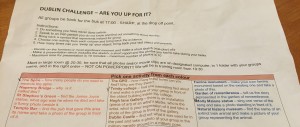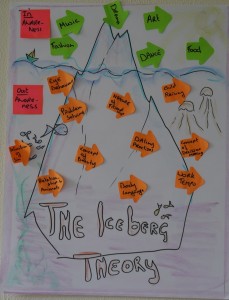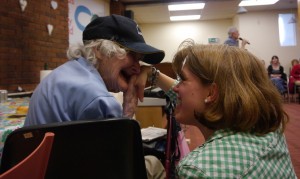All about On-arrival training for volunteers
Nadine Eckmann has come from Germany to do a one-year European Voluntary Service (EVS) placement with Friends of the Elderly Ireland in Dublin. Here, she explains how EVS on-arrival training helped her settle into her placement and new life in Ireland.
“We had our on-arrival training in the EMMAUS Centre in Swords, Co. Dublin, a lovely venue. We met other EVS volunteers from around Europe and were surprised at how many different nations gathered together: volunteers from Germany, Russia, Romania, Spain, Italy, France, Ukraine, Hungary... One thing was already clear: we were in for an exciting weekend! In the first part of the training we spoke about why we wanted to participate in EVS, and all of us presented the organisations or projects we would be working with for the next six to twelve months. This part was especially exciting for me, as it was great to see how enthusiastic everyone was.
The next day began with a guided meditation, helping us to reflect on our experience with EVS and how our perspective might have changed since we first applied. This made me aware what a long road is behind me. After months of planning, I am finally in Ireland and have started my EVS placement! After this beautiful exercise we had time to talk together; it was great to hear that others feel the same as me and even had some of the same experiences. Then we had a visit from Naoise Wilkinson, the EVS coordinator in Léargas, who answered our questions and cleared up any ambiguities. After lunch we headed into the city centre for the ‘Dublin Challenge’!
 The ‘Dublin Challenge’ was designed to help us come out of our own comfort zones, to try something new and overcome personal limitations. In small groups, we completed various tasks around the city. We found the oldest building in Trinity College; interviewed a complete stranger and found out some interesting facts about his life (he was a Natural Sciences student, from Donegal and had a twin brother); found the Molly Malone statue and sang the song about her; and then found out how many people it takes to hug the spire (nine, since you ask!). As the day coincided with ‘Culture Night’, we ended our Dublin adventures with traditional Irish music and dancing in the EMMAUS centre. That was just wonderful, and helped us all dive into Irish culture in a different way.
The ‘Dublin Challenge’ was designed to help us come out of our own comfort zones, to try something new and overcome personal limitations. In small groups, we completed various tasks around the city. We found the oldest building in Trinity College; interviewed a complete stranger and found out some interesting facts about his life (he was a Natural Sciences student, from Donegal and had a twin brother); found the Molly Malone statue and sang the song about her; and then found out how many people it takes to hug the spire (nine, since you ask!). As the day coincided with ‘Culture Night’, we ended our Dublin adventures with traditional Irish music and dancing in the EMMAUS centre. That was just wonderful, and helped us all dive into Irish culture in a different way.
 The next day was all about working, listening and reflecting. We spoke about our own cultures and also that of Ireland. Something that really helped us was the explanation of the so-called ‘iceberg model’. It shows that some areas of culture are "on the tip of the iceberg", so the differences can easily be seen (e.g. language, customs, clothing, food). However the vast majority of cultural differences remain hidden "under the surface", such as norms, values, beliefs, and philosophy. The areas below the water surface are not directly visible to people who are not familiar with the culture. However, they influence the visible aspects of culture very strongly. Only by knowing these hidden areas can one can understand a foreign culture. This was really helpful for me personally as my goal is to immerse myself in Irish culture, and-in addition to the opportunity to meet so many great people-was the most important part of the weekend for me.
The next day was all about working, listening and reflecting. We spoke about our own cultures and also that of Ireland. Something that really helped us was the explanation of the so-called ‘iceberg model’. It shows that some areas of culture are "on the tip of the iceberg", so the differences can easily be seen (e.g. language, customs, clothing, food). However the vast majority of cultural differences remain hidden "under the surface", such as norms, values, beliefs, and philosophy. The areas below the water surface are not directly visible to people who are not familiar with the culture. However, they influence the visible aspects of culture very strongly. Only by knowing these hidden areas can one can understand a foreign culture. This was really helpful for me personally as my goal is to immerse myself in Irish culture, and-in addition to the opportunity to meet so many great people-was the most important part of the weekend for me.
I’m looking forward to staying in touch with all the other EVS volunteers and using my new knowledge to have a great EVS experience. You can follow my time in Ireland on my blog, All Signs Turned Green!”
All images courtesy of Nadine Eckmann. EVS is part of Erasmus+ Youth Key Action 1. We welcome contributions and ideas for ‘Insights’ at comms@leargas.ie.

